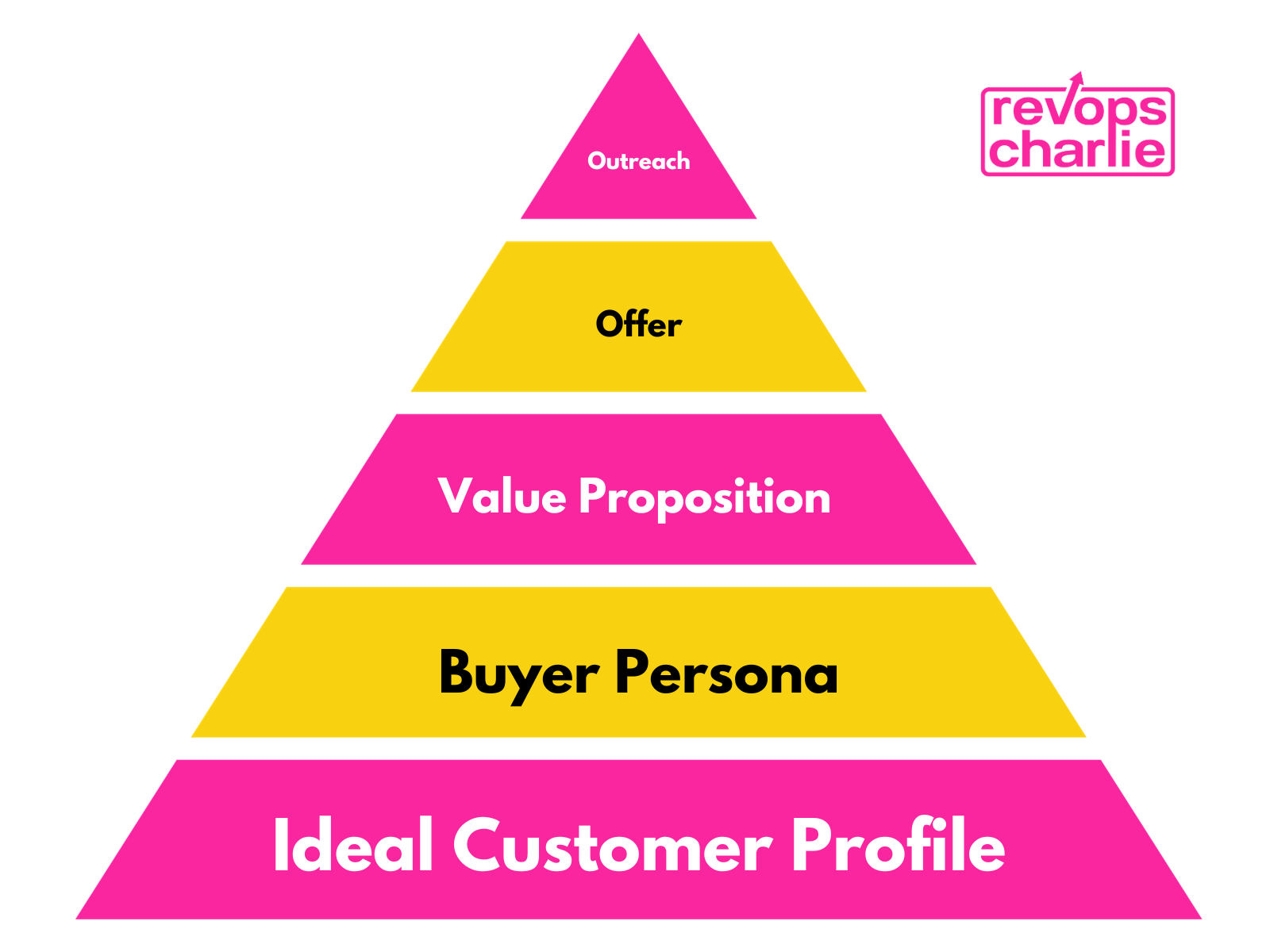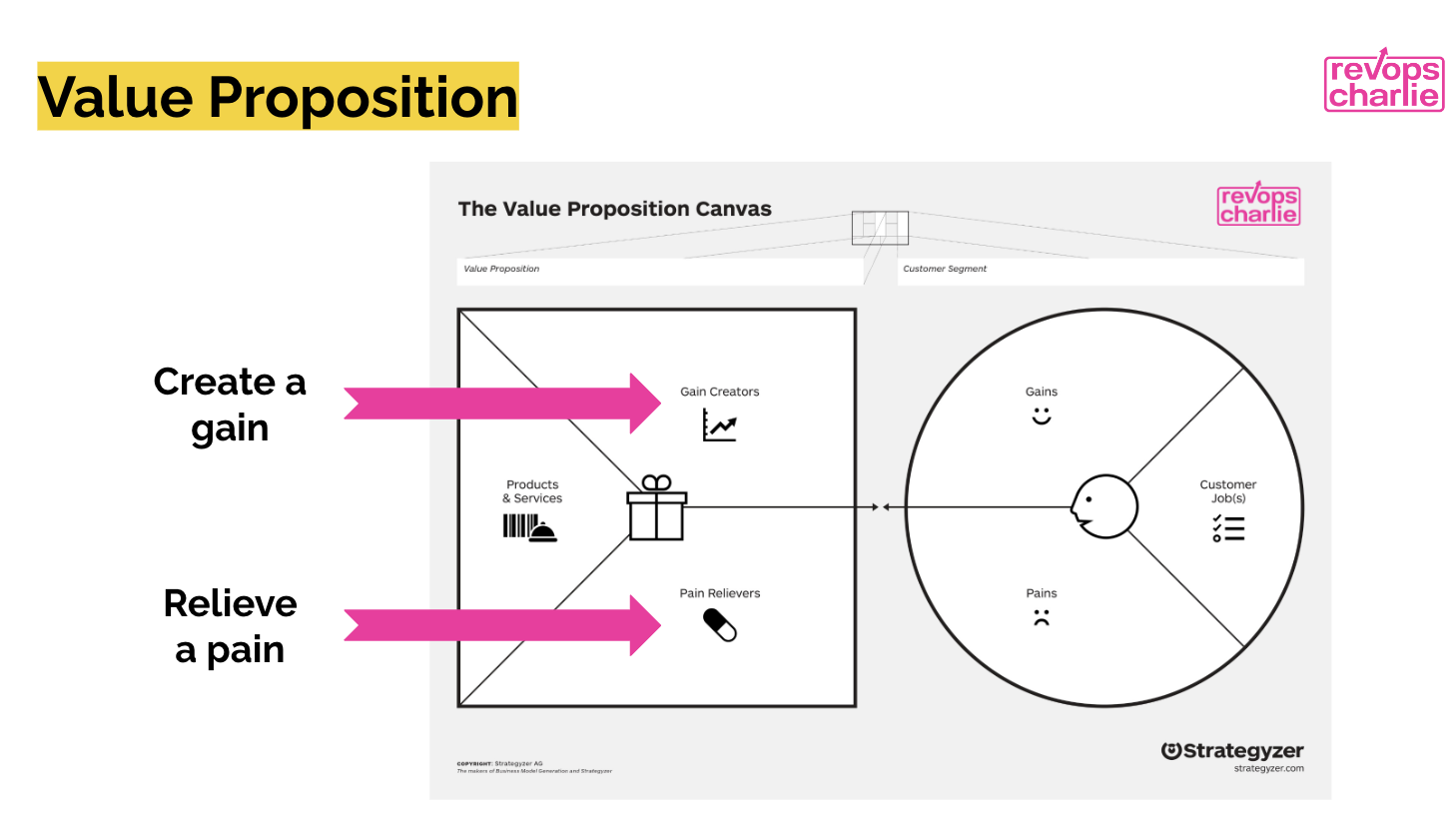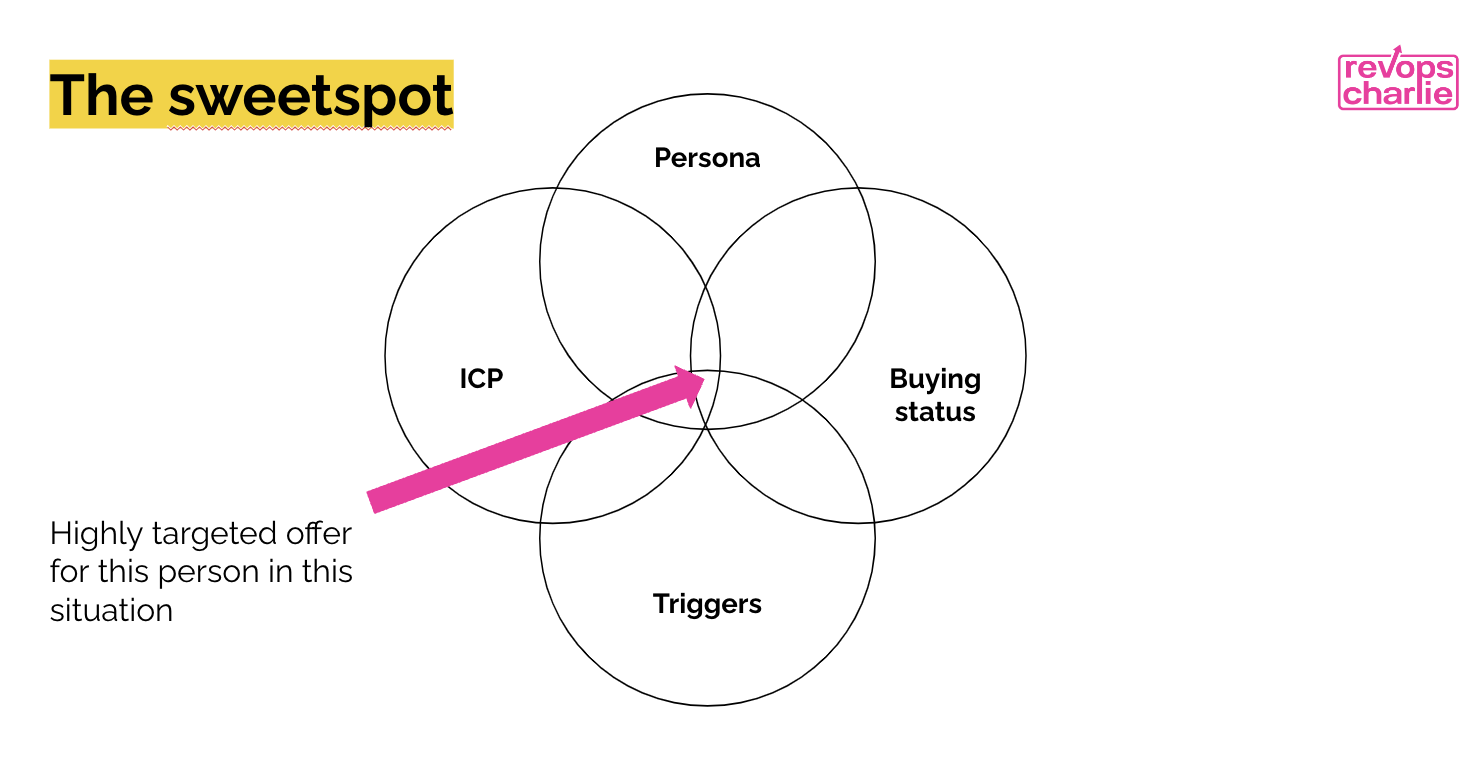Prepare your outbound campaigns with the Pipeline Pyramid
Everyone needs more pipeline - and the temptation is to just “do stuff”.
Let’s just launch an email campaign.
Let’s organise some webinars.
Let’s get the team to do a calling day.
Emily Kramer at MKT1 calls these ‘random acts of marketing’ and they tick your box of looking busy - but rarely end up in quality pipeline or closed revenue.
Instead, for any outbound activity you are planning I recommend you look through the lens of the pipeline pyramid.
The tip of the spear is your outreach - either by your marketers, your sellers, or your RevOps team via Digital SDRs.
But before we get to the tip of the spear we must go back to the bottom of the pyramid and travel upwards, without skipping any steps.
Ideal Customer Profile
We must always anchor ourselves in the target accounts that we want to approach.
Any outreach that lands outside of this target area is likely to fail - either in low pipeline, low conversion, or high churn down the road.
When considering your Ideal Customer Profile consider this specific campaign you are running.
The ICP for this particular product
The ICP for this particular geographical region
The ICP for this particular customer size
The ICP for this particular sales channel
In the Go To Market Handbook for B2B SaaS leaders the authors talk about getting ‘uncomfortably narrow’.
You want to feel that the ICP you have selected is too small. Then halve it again.
Our ICP is large retailers, finance and healthcare companies in Europe - bad
Our ICP is mid-size consumer digital banks in Germany - better
Which ICP is going to be the target for this campaign?
By narrowing in on a discrete set of accounts your next steps will be much easier.
Buyer Persona
Now we can look at the individual roles that exist within that very specific ICP.
Who are the individuals that would be involved in a buying decision, implementation, use or support of our product or service.
Go wider than the core buying team of your champion and the economic buyer.
Who do they go to for advice?
Legal? Infosec? Their System Integrator partner? Their Learning and Development teams.
The typical buying group has between 10 and 20 people in it - even larger for Enterprise and Strategic accounts.
Who are they?
Which buyer persona are you going to target for this campaign?
Using your contact data tool build out a list of target contacts within your ICP that you will use later on in your outreach.
Value Proposition
For your chosen buyer persona, what do you know about their role - their jobs to be done?
We split their jobs to be done into three:
The main job: what is in their job description and what do they actually do - hire people, buy things, sell things, manage budgets, manage systems - what is their job?
Emotional jobs: what do they want out of their job, their career and their personal lives - promotion, move to a new company, more time with the family, an easy life, a more challenging role,?
Social jobs: how do they want others to perceive them - competent, a leader, confident, funny, easy to work with, innovative?
We then want to consider:
their desired gains - a job promotion, a new role, getting married, moving home
the pains preventing the gains - manual work, system downtime, long hours at work
By truly understanding the desires and pains of this persona we can then match elements of our products and services to uniquely match these.
The Value Proposition Canvas comes from strategyzer.com
How does your product help this individual feel more secure in their job or give them more time with their family?
Offer
We can’t just take our product direct to this individual - they don’t even know who we are yet, and if they do they certainly aren’t ready to talk solutions.
First we need to craft an offer for them - something of value that we are going to reach out to them with.
Eric Nowoslawski at GrowthEngineX talks about your offer being so good that the person receiving it cannot believe you’ve just given it to them.
In his line of business (a lead gen agency) his offers include 5,000 free ICP leads, Lookalike company search and setting up a retargeting workflow.
These are offers of great value and meet the prospect in the sweetspot - the right ICP, the right persona, relevant to where they are in their buying journey and using relevant triggers within the email and offer.
When crafting your offer - think about the buyer persona and their pains and desired gains - how can you help them in their role at this stage of their buying process with low or no investment from them?
Actual work/recommendations (here’s what I think)
Faux work/recommendations (OK for me to share what I think?)
A current state audit template
A framework for assessing solutions
A calculator to help them assess their situation
A benchmark to assess against their peers
Unique data from your product/customers (great for freemium models)
Note: faux work is where you let them know that you’ve completed an assessment and have specific recommendations to share.
“I’ve completed a video assessment of your website and have 3 suggestions to improve your conversion rate. OK for me to share?”
Only when the customer responds to you do the work, which reduces your time commitment on those that don’t respond.
The litmus test for your offer is: if your CEO sent this directly to this contact would they get a positive response?
If the offer is truly valuable the answer is likely yes
If the offer is weak the answer is likely no
Weak offers include:
An upcoming webinar
An ebook
A blog post
An in-person event
I’m not saying these aren’t valuable - but they are weak offers - each of these asks the recipient for something (their time) with very little value in return.
Outreach
Having now crafted a valuable offer that delivers a strong value proposition to an individual buyer persona in a specific ideal customer profile you can now plan your outreach.
How will you take this message to your contacts?
Will your marketing team launch a campaign?
Will you enable your SDRs and AEs to take the offer out to their prospects?
Or will you deliver the message at scale via a digital SDR program?
If you have crafted a focused list of contacts in the buyer persona phase, I’d recommend conducting the initial outreach at scale via a Digital SDR program.
Your campaign can be set up with multiple emails, varying offers, contacting multiple personas in parallel.
Where prospects engage they can be funnelled directly to your AEs, or to SDRs for further qualification.
Where prospects don’t engage your SDRs can complement the Digital SDR program with social and phone outreach.
Always start at the bottom of the pipeline pyramid
In the clients I work with I see a lot of campaigns get started at the top (outreach) or the middle (value proposition),
Let’s do an email blast into manufacturing (outreach)
Let’s do a campaign on the new security product (value proposition)
These campaigns miss the pyramid’s foundations - for this campaign who is the ICP, who is the buyer persona and what are their desired gains and current pains?
These campaigns have weak offers - what are we taking to the customer that is of true value to them?
Without these you risk spinning your wheels. Very busy but no pipeline.
Get started
Whenever you are ready, there are three ways that I can help you accelerate your revenue.
RevOps Maturity Assessment - Take my free 22 question assessment and receive specific suggestions on how to improve your revenue growth.
Business Model Design Workshops - I’ll work with you and your team to design or refine a business model and value propositions for a new or existing product.
Pipeline Emergency Rescue - I’ll fix your pipeline problem in 12 weeks, working across your revenue teams to create and launch refined value propositions, buyer enablement tools, and new campaigns.




